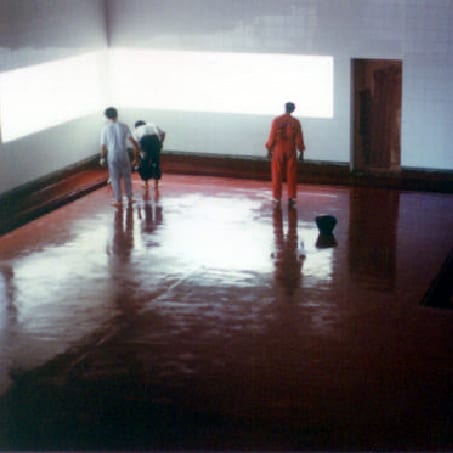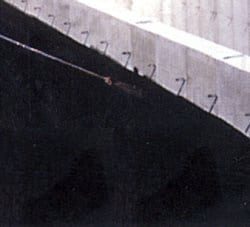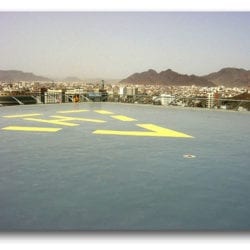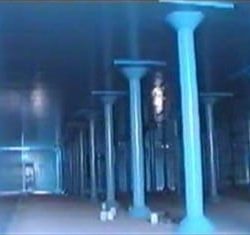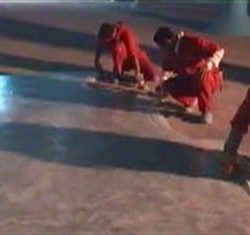USES
CHEM-NOVOLAC is used as a chemical resistant coating and or binders for aggregate-filled trowel-applied toppings. CHEM-NOVOLAC can be used as a protective top coating for other epoxy systems to provide improved surface chemical resistance in:
- Chemical Plants
- Pulp and Paper Mills
- Food Processing Plants
- Dairies, kitchens, and meat processing plants
- Battery Storage and Charging Areas
- Plating and galvanizing Plants
- Waste Treatment, effluent treatment, and seawater Plants
- Pharmaceutical, medical and laboratory facilities
- Steel and Copper production facilities
TECHNICAL
Technical Data for Unmixed Parts
| Property @ 25°C (77°F) |
Resin – Part A |
Hardener – Part B |
Test Method |
| Solids |
100 % |
100 % |
– |
| Color* |
Red, Medium Grey* |
Amber |
– |
| Density, Lb/Gal (Kg/L) |
12.37 (1.48) |
< 8.13 (0.97) |
ASTM D1475 |
| Mixing Ratio A : B |
3 : 1 By Volume |
– |
| Shelf Life |
2 years |
2 years |
– |
* Custom colors are available upon request.
Technical Data for Mixed Parts
| Property (Mixed A & B) |
Value @ 25°C (77°C) |
Test Method |
| Mixed Density, Lb/Gal (kg/L) |
11.31 (1.36) |
ASTM D-1475 |
| Mixed Viscosity (Clear), cP |
5000 – 6000 |
Brookfield |
| Mixed Color |
Red or Medium Grey |
–
|
| Gel Time @ 60 grams, minute |
45 |
ASTM D-2471 |
| Pot Life @ 1 Quart (1 Liter), minute |
30 |
–
|
| Shore Hardness @ 3 Days, D |
86 |
ASTM D-2240 |
| Bond Strength to concrete |
Concrete Failure |
ASTM D-4541, Method C |
| Cure Time for Foot Traffic, hour |
16 – 24 |
–
|
| Maximum Recoat Interval, hour |
24 – 36 |
–
|
| Final Cure, day |
3 |
–
|
Chemical Resistance: Tests are performed according the ASTM D543 – Practice A (Immersion test for 7 days at 25°C/77°F)
| Chemical Name |
Resistance |
| Sulfuric Acid 70% |
Excellent |
| Sulfuric Acid 98% |
Excellent* |
| Hydrochloric Acid 38% |
Excellent |
| Hydraulic Oil |
Excellent |
| Isopropyl Alcohol 99% |
Excellent |
| Xylene |
Excellent |
| Citric Acid 50% |
Excellent |
| Sodium Hydroxide 50% |
Excellent |
| Alkylbenzenesulfonic Acid |
Excellent |
| Nitric Acid 30% |
Good |
| Diesel |
Excellent |
| Acetic Acid up to 50% |
Excellent |
| H2O2 at 31% |
Excellent |
| HF at 50% |
Excellent |
| H3PO4 at 85% |
Excellent |
| Gasoline |
Excellent |
| Acetone |
Excellent |
| Boric Acid |
Excellent |
| Brake Fluid |
Very Good |
| Brine |
Excellent |
| Citric Acid |
Excellent |
| Detergent Solution |
Excellent |
| Ethyl Alcohol |
Very Good |
| Jet Fuel |
Excellent |
| Distilled Water |
Excellent |
| Skydrol |
Very Good |
*Slight Color Change but no change in mechanical properties.
Note: refer to manufacturer for resistance of other reagents.
Coverage:
- As a Protective Coating: apply material at a minimum rate of 100 ft2 (9.3 m2) per gallon (16 mils dry film thickness) and allow to cure for 24 hours @ 77oF (25oC) before allowing foot traffic.
- As a Mortar Screed: Mixing Ratio is approximately 1: 5 by weight. Recommended sand sizes as follows:
| CHEM-NOVOLAC binder (Part A & B) |
2.2 Lb (1 kg) |
| Silica sand 0.1-0.3 mm |
5.5 Lb (2 ½ kg) |
| Silica sand 0.4-0.8 mm |
5.5 Lb (2 ½ kg) |
APPLICATION
Limitations: Do not apply when temperature is below 10°C (50°F).
Surface Preparation:
New Concrete Surface: new concrete or cementitious substrates should be at least 28 days old and moisture content of the substrate should be less than 5%. Concrete to receive high performance overlay systems should be designed, mixed and placed in accordance with internationally accepted practice. Sufficient compressive and tensile strengths to withstand dynamic loading is required. Good surface is essential; too dense concrete’s surface caused by over trowelling or finishing with steel floats can lead to adhesion failure. All laitance and loose materials must be removed from the concrete surfaces. If the concrete is strong, crack-free and sound with light laitance, surface preparation may be achieved by acid etching followed by thorough water washing using high pressure water jetting ensuring all traces of acids are removed. Cracked or damaged concrete or heavy laitance should be removed and prepared by grit blasting, scrabbling or mechanical grinding until a solid surface is reached showing exposed aggregate.
Existing Concrete Surfaces: remove all surface laitance, loose particles, dust and all contaminations exposing a clean sound substrate. Mechanical means of preparation is preferred followed by industrial vacuum cleaning. In areas of deeply penetrating contaminations by oils, greases and fats should be flame cleaned by hot compressed air or thoroughly washed by good industrial detergent. The cleanly washed substrate is then allowed to dry completely. Un-even concrete surfaces should be leveled to produce a smooth flat surface using an appropriate epoxy repair mortar technique. Expansion, control and isolation joints in concrete substrates should be maintained through the epoxy system and filled with an appropriate sealant.
Steel: the base metal should be free from rust, scales grease, oil, and any other impurities, which impairs the strong adhesion of coating.
Corroded steel should be shot blasted to Swedish Standard SA 2½ achieving bright metal surface.
Where shot blasting is impractical, pre-treatment may be carried out using needle guns, tap hammers, rotary wire brushes fitted to grinder or drill, mechanical grinding, etc. Cleaning with solvent is advisable to ensure surface is free from grease or oil.
The coating work should be carried out immediately or at maximum 2 hours after pre-treatment of steel surfaces.
CHEM-NOVOLAC is applied on steel at 8 mils (200 microns) dry film thickness per application. This is equivalent to coverage rate of 200 ft2 (18.60 m2) per gallon.
Mixing: should be stored under cover in dry conditions and protected from extremes of temperature Prior to application, the product, extremes of temperature may cause inconsistent workability, finish and cure times of the mixed material. Ideally, at least 24 hours before mixing, the product should be maintained at approximately 68°F (20°C).
Mechanical mixing of both components part A and part B is the most efficient and effective method.
Mix thoroughly, three parts by volume of part A with one part by volume of part B, make sure to scrape the sides and bottom with a slow speed electric drill fitted with a mixing paddle. Do not mix more material than can be applied in 30 minutes. Ensure a smooth uniform homogenous color mixture.
Application as a Protective Coating: it is recommended to apply CHEM-NOVOLAC in two coats applications.
First coat: apply the first coat of CHEM-NOVOLAC onto the pre-treated dry substrate using a good quality paintbrush or roller. Spread the mixture to an even and smooth finish free from streaks of brush or roller marks. Allow the first coat to cure overnight.
Second coat: the second coat of CHEM-NOVOLAC should be installed on the cured first coat within 24 hours of first coat application. Should there be any delay in application of second coat longer than 24 hours, the surface must first be roughened up by a light brush, blasting or by sandpaper, this process will ensure a good mechanical bond between the two coats. Second coat should be installed in the same procedure as in first coat. Make a neat smooth even finishing of second coat.
Thickness of the coating may vary according to the desired specification of dry film thickness from 400 microns to 800 microns.
Application as Epoxy Mortar Screed:
Primer: the substrate can be primed with Chem-Prime, apply at a minimum of 200 ft2 (18.6 m2) per gallon (8 mils dry film thickness). Primer should be tack free before applying base coat.
Mortar: prepare the mortar system by adding 5 parts by weight of silica sand (0.1-0.3 mm and 0.4-0.8 mm mixture) to one part by weight of CHEM-NOVOLAC. Blend the mortar until achieving a uniform homogenous consistency.
Screed CHEM-NOVOLAC mortar onto the primed area, rake to distribute then compact well and trowel to finish. When used as a Mortar screed, it is recommended that one or two top coats of CHEM-NOVOLAC be applied to seal the surface against chemicals and acids attacks.
Curing: Allow the coating system to cure for minimum of 24 hours before allowing its use for light foot traffic. Heavy traffic and chemicals should not be allowed until after 72 hours.
Cleaning: remove uncured CHEM-NOVOLAC from tools and equipment with suitable solvents such as Xylene, Toluene or CHEM-CRETE BLENDED SOLVENT immediately after use. Cured material may only be removed mechanically.
STORAGE
Store in dry and cool area between 40°F to 95°F (5°C to 35°C). Protect from direct sunlight and freezing. Product can be stored in original unopened container for one year.
SAFETY
After full curing, the product is physiologically harmless. Keep the resin and hardener away from the eyes, mouth and skin. Do not inhale vapors. Uncured mixture can cause irritation of the skin. The best precaution is to wear safety protective gloves, overall, mask and goggles while working. Skin contamination should be immediately cleaned with soap and plenty of water. The use of solvents should be avoided. If resin or hardener splashes into the eyes, wash immediately with running water. A Doctor must be visited in all cases. Forced ventilation should be provided when working with solvents, etc.
WARRANTY
LIMITED WARRANTY: International Chem-Crete Inc. warrants that, at the time and place we make shipment, our materials will be of good quality and will conform to our published specifications in force on the date of acceptance of the order.
DISCLAIMER: The information contained herein is included for illustrative purposes only and, to the best of our knowledge, is accurate and reliable. International Chem-Crete Inc. is not under any circumstances liable to connection with the use of information. As International Chem-Crete Inc. has no control over the use to which others may put its products, it is recommended that the products be tested to determine the suitability for specific applications and/or our information is valid in particular circumstances. Responsibility remains with the architect or engineer, contractor and owner of the design, application and proper installation of each product. Specifier and user shall determine the suitability of the product for specific application and assume all responsibility in connection therewith. AM22319.

